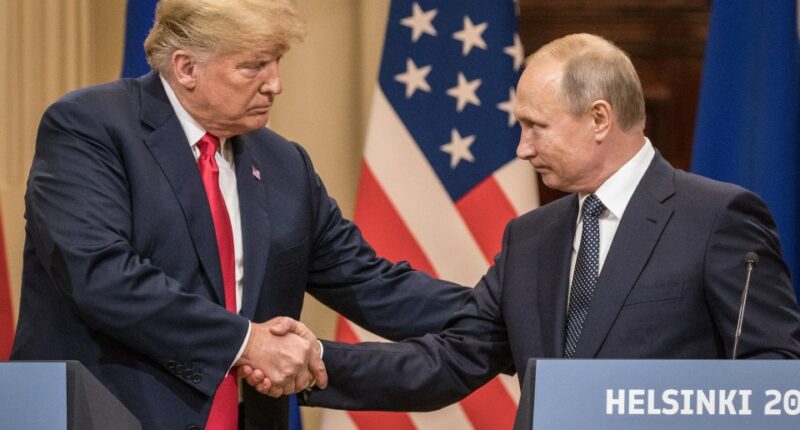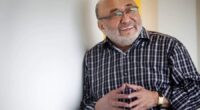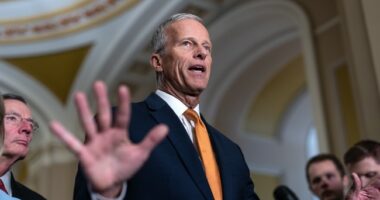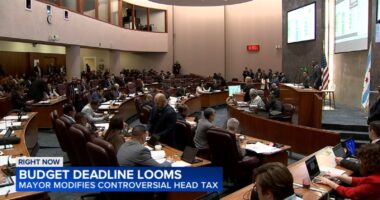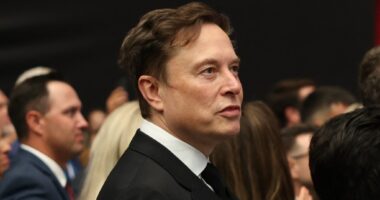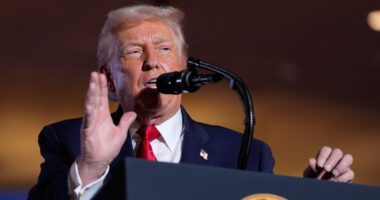Share this @internewscast.com
A HISTORIC meeting between Donald Trump, Vladimir Putin and maybe Volodymyr Zelensky could finally decide the fate of the war in Ukraine.
With battlefields burning and sanctions ready to bite, this diplomatic showdown could be the start of peace – or another powder keg.
This isn’t just another summit – it’s a historic high-stakes gamble.
Trump is betting big that Putin wants peace, that Zelensky can stomach compromise, and that America’s economic firepower can bring the war to an end.
Here is everything you need to know about the major meeting and the men comprising the most explosive political triangle in years.
When and where could the summit take place?
Trump could sit down with Mad Vlad Putin as early as next week, according to the White House.
A trilateral meeting including Zelensky is also on the table – a diplomatic first if it happens.
Yuri Ushakov, a key adviser to Putin, revealed that a bilateral summit has been tentatively planned for the near future, after a proposal from the American side.
All parties are now working on the details, and while the venue has been agreed, it will be revealed later.
US special envoy Steve Witkoff, during discussions with Putin, also suggested the idea of a trilateral meeting with Zelensky, although Ushakov mentioned that Moscow has not formally responded to this proposal yet.
Don and Vlad last met in person at the G20 summit in Osaka, Japan, on June 28, 2019, during Trump’s first term as America’s leader.
And if Zelensky joins the upcoming meeting, it would mark the first time all three leaders sit at the same table since war erupted in 2022.
What will be discussed?
One issue dominates: peace in Ukraine.
Trump’s administration says it is pushing hard for a deal.
His special envoy, Steve Witkoff, just wrapped up a three-hour meeting with Putin in Moscow this week, which Trump called “highly productive”.
But there’s a clock ticking.
The Republican strongman slashed his original 50-day deadline for a Ukraine peace deal to just 10 days – and that deadline expires Friday.
If Putin doesn’t budge, Trump is poised to hammer Moscow – and its enablers – with crippling secondary sanctions.
India has already been hit with 50 per cent tariffs over its Russian oil purchases – and China could be next.
Trump warned: “We did it with India. We’re doing it probably with a couple of others. One of them could be China.”
The White House says Trump has made it clear there will be “biting sanctions” if Russia doesn’t agree to a ceasefire.
Who has the upper hand?
Right now, everything hangs in the balance – and the power dynamic could shift in a heartbeat.
Hamish de Bretton-Gordon, former British Army officer and military analyst, said the fact the summit is even happening is a win in itself.
But as for who’s calling the shots? That’s where things get complicated.
An expert told The Sun that President Putin, believing he is still advancing in Ukraine, has shown little interest in achieving peace until recently.
“His aim at the beginning of his special military operation over three and a half years ago was to subjugate the whole of Ukraine.”
According to de Bretton-Gordon, Trump has only recently woken up to the fact that he’s being played.
“It would appear that Trump has had a bit of an epiphany, a bit of a change of mind, and has now realised that Putin has been playing him.”
And now, Don is bringing the businessman in him and threatening to hit Russia where it hurts most: the wallet.
De Bretton-Gordon explained that if Trump implements sanctions and tariffs, this might be why Putin is willing to negotiate.
Experts in the economic field suggest that without substantial income and resources from oil, the Russian economy could decline rapidly.
In other words, Trump holds the economic sledgehammer — if he’s willing to swing it.
But Putin isn’t out of the game. His forces are still advancing, still hammering Ukrainian cities, and still killing civilians.
“Russia seems to be moving forward slowly,” de Bretton-Gordon warned.
“Attacking civilian targets in Ukraine at an unbelievable scale.”
Zelensky, meanwhile, remains the wild card.
“The people who are most important here are the Ukrainians,” he said.
“A bad deal for Ukraine is worse than no deal at all.”
And that’s the real risk. Trump might be chasing headlines, not justice.
“I think Trump probably just wants to get a deal of some description,” the former army officer said.
There is a concern that Trump might attempt to make a covert agreement with Putin to claim peace in Ukraine, but short-term peace would be ineffective.
So who has the upper hand? Right now, it’s still up for grabs.
But if Trump sticks to his economic guns, and if Putin starts to feel the heat on the home front, the balance might just tip.
Alan Mendoza, executive director of the Henry Jackson Society think tank, said Trump’s role could be pivotal.
He told The Sun: “Donald Trump always has the cards in the sense that he is the person who can make the most difference in this conversation.
“A lot depends frankly, on both sides how they manage Donald Trump.”
He pointed to the sections threat as a real lever, adding: “That secondary sanctions pitch could be very damaging to Russia’s economy… the pressure is being brought on Vladimir Putin finally to make some progress here.”
But security expert Anthony Glees argued it’s Trump who thinks he’s on top, which is not necessarily the reality.
“I can tell you who thinks he’s got the upper hand in this summit, and that’s President Donald J. Trump,” he said.
“Trump thinks he is the strongest. However, we need to ask whether he really is.”
And Glees is fearing the worst: “My fear is that the person who not only thinks he is the strongest, but actually will prove to be the strongest is Vladimir Putin… and the person who is weakest, unfair though it is, is Volodymyr Zelensky.”
Will Trump be able to make a deal?
That’s the trillion-dollar question.
Trump insists he’s serious.
He’s been increasingly frustrated with Putin, telling reporters: “Can’t answer the question yet. I’ll tell you in a matter of weeks, maybe less. But we made a lot of progress.”
Zelensky says the pressure is working.
“It seems that Russia is now more inclined to a ceasefire,” he said, but warned, “The main thing is that they do not deceive us in the details – neither us nor the US.”
Putin, for his part, has not ruled out a meeting with Zelensky – a U-turn after rejecting talks for nearly five years.
But the Kremlin remains cagey.
Aides say they’re open to a summit “after preparatory work is done at the expert level.”
Still, Russia continues to play the long game.
Putin’s demands for peace remain unchanged, and behind the scenes, Moscow is preparing for no limits on nuclear deployments – a chilling echo of Cold War escalation.
If talks fail, Trump’s next move could ignite a global trade war.
A 100 per cent tariff on all Russian goods and those of its allies is on the table. His message to Moscow? Deal or suffer.
What is the situation on the frontline?
While diplomats talk, Putin bombs.
Russia has escalated its attacks in Ukraine in recent days – in what some see as a final show of force ahead of the talks.
Kyiv, Kherson, Nikopol, Dnipropetrovsk – all hit.
One missile slammed into a residential tower, killing 31 people, including five children.
In Nikopol, a 23-year-old first responder was among the dead.
Putin’s war machine has launched hundreds of drones and missiles overnight in a relentless blitz.
Even as Moscow talks ceasefire, its rockets keep flying.
Ukrainian forces, meanwhile, have not backed down – striking deep into Russian territory with precision attacks on refineries, rail hubs, air defences and even military units inside Russia.
The Afipsky Refinery in southern Russia went up in flames after a massive Ukrainian strike – a clear message that Kyiv can hit back hard.
Just days ago, Russia declared there are now no limits on its deployment of nuclear missiles in a chilling warning to the West.
Throwing off its gloves and restraints, Moscow vowed to match US and Nato moves with force, reigniting fears of a Cold War-style arms race.
The Russian Foreign Ministry accused America and its allies of creating a “direct threat to the security of our country” by preparing to deploy intermediate-range weapons in Europe.
Saying Moscow now has a free hand to respond, Kremlin spokesman Dmitry Peskov told reporters: “Russia no longer considers itself to be constrained by anything.
“Therefore Russia believes it has the right to take respective steps if necessary.”
The trigger, according to Russia, is the planned US deployment of Typhoon and Dark Eagle missiles in Germany starting next year.
The Kremlin said the move shattered what remained of strategic stability, accusing Donald Trump’s USA of risking “a dangerous escalation of tensions between nuclear powers.”
It was the clearest warning yet that Vladimir Putin is prepared to redraw the red lines of nuclear deterrence — and challenge the West head-on.
Will there be peace in Ukraine?
THE prospect of peace in Ukraine remains uncertain as the Russia-Ukraine war continues into its fourth year.
While Trump’s diplomatic efforts and the planned meeting signal continued U.S. engagement, the gap between Russia’s demands and Ukraine’s conditions remains wide.
Putin’s history of stalling and Zelensky’s insistence on a full ceasefire and security guarantees suggest that a lasting peace agreement is unlikely in the immediate term without significant concessions from either side.
Next week’s meeting may produce a framework or memorandum for future talks, as Putin has indicated, but a concrete peace deal appears distant based on current dynamics.
Recent US-brokered talks, including direct negotiations in Istanbul on May 16 and June 2, 2025, have yielded no breakthroughs, though agreements on prisoner exchanges signal some dialogue.
US President Donald Trump has pushed for a ceasefire, shortening a 50-day deadline for Russia to negotiate or face sanctions, but tensions persist with Russian advances in eastern Ukraine and intensified drone and missile strikes on cities like Kyiv.
Ukrainian President Volodymyr Zelensky has suggested territorial swaps, while Russia shows little willingness to compromise.
With ongoing military escalation and divergent American and European approaches, a lasting peace deal appears distant.
